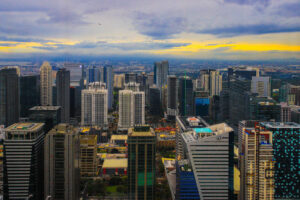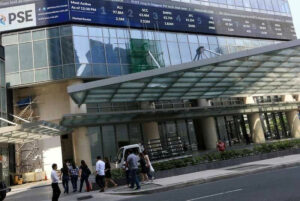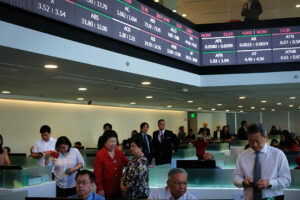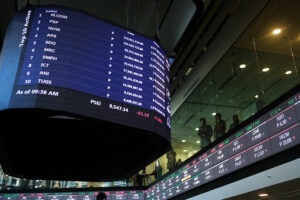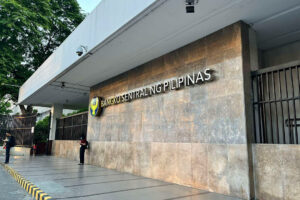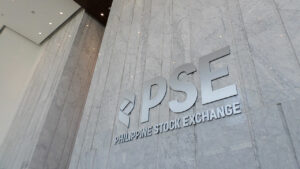The Bangko Sentral ng Pilipinas (BSP) expects the country’s balance of payment (BoP) position to swing to a deficit this year, as well as post a wider current account deficit, largely due to global trade volatilities.
“The Philippine BoP position is projected to be weaker in 2025-2026 due to slower global trade and subdued investor confidence linked to increased uncertainty in global trade policy and geopolitical developments,” it said in a statement late on Monday.
“The outlook nevertheless reflects sustained expansion in the domestic economy, supported by easing inflation and less restrictive monetary policy.”
The central bank’s latest projection shows the overall BoP will register a deficit of USD 4 billion this year, equivalent to -0.8% of gross domestic product (GDP).
This is a reversal from its earlier forecast of a USD 2.1-billion surplus (0.4% of GDP) for 2025.
In 2024, the BoP position stood at a surplus of USD 609 million, plunging by 83.4% from the USD 3.672-billion surplus at end-2023.
The BoP provides a glimpse of the country’s transactions with the rest of the world. A deficit indicates that more funds exited the economy while a surplus shows more money entered than left.
The BoP deficit is expected to widen to USD 4.3 billion next year but still at -0.8% of GDP.
“For 2026, the overall BoP is anticipated to remain in deficit, consistent with the expected widening of the current account deficit relative to the 2025 forecast,” the BSP said.
The central bank said sustained financial account net inflows will support the BoP outlook next year, but cited persisting downside risks, such as trade uncertainties, weak global growth and geopolitical tensions.
“The overall BoP position is expected to show a deficit in 2025 and in 2026, with a wider current account gap resulting from a higher trade-in-goods deficit and lower net receipts in trade-in-services,” the BSP said.
Meanwhile, the current account deficit — which covers transactions involving goods, services, and income — is expected to reach USD 19.8 billion this year, equivalent to -3.9% of economic output.
This is wider than its earlier forecast of a USD 12.1-billion current account deficit (-2.4% of GDP).
For 2026, the current account deficit is projected to hit USD 21.2 billion (-3.9% of GDP).
Latest data from the BSP showed the current account deficit widened by 41.4% to USD 17.5 billion last year from USD 12.39 billion in 2023.
This also marked the second-largest current account deficit on record, after the USD 18.3-billion gap recorded in 2022.
Modest exports growth
Meanwhile, the BSP lowered its goods exports growth forecast to 1% this year from 4% previously. It expects goods exports to expand by 2% next year.
“Merchandise exports are anticipated to record modest growth in 2025 and 2026 after two consecutive years of decline in 2023 and 2024.”
“Semiconductor exports will see flat growth in 2025, attributed largely to the ongoing inventory correction and as the industry works to keep pace with the rapidly evolving global demand.”
The BSP also trimmed its growth projection for goods imports to 4% from 5% earlier. Goods imports are seen to grow by 4% in 2026.
Service exports’ growth was also slashed to 8% from 10% previously. The BSP expects service exports to grow by 8% next year.
It said that service exports are seen to register a “modest expansion” amid weaker business process outsourcing (BPO) services.
“The outlook for BPO services incorporates the adverse impact of the US job reshoring agenda, as well as the domestic challenges in the supply of skilled workers in Generative AI and data analytics.”
This could “hamper industry efforts to climb up the value chain and maintain competitiveness,” it added.
BPO revenues are seen to grow by 5% this year and in 2026. This was a tad slower than the previous forecast of 6% for 2025.
Travel receipts are projected to expand by 11% this year, much slower than its previous forecast of 20%.
“Growth in Philippine tourism activity is expected to return to its pre-pandemic trend supported by the continued influx of international tourists, particularly from Korea and Japan,” it added.
On the other hand, the BSP anticipates service imports growth to accelerate to 14% this year from 8% previously. Its 2026 growth forecast is at 12%.
“Overseas Filipino (OF) remittances are expected to grow slightly below the long-term trend as major OF host economies, such as Saudi Arabia and Qatar, increasingly advocate for the localization of their workforce, affecting OFWs’ (overseas Filipino workers) deployment prospects,” it said.
The central bank also trimmed its cash remittance growth projection to 2.8% this year from 3% earlier. Cash remittances are expected to grow by 3% next year.
However, the United States’ harsher immigration policies are seen to have a minimal effect on remittance flows, the central bank said.
“Most US-based Filipinos are composed of permanent residents and documented migrants and fewer than 1% of total land-based OFWs are deployed in the US.”
Meanwhile, the BSP said the financial account will be “buoyed by sustained net inflows from both foreign direct and portfolio investments.”
“Investor interest will be supported by the country’s macroeconomic fundamentals, along with ongoing reforms to enhance the ease of doing business, optimize tax incentives, and improve capital market efficiency.”
Financial account outflows could reach USD 16.2 billion this year and USD 17.8 billion in 2026.
The financial account records transactions between residents and nonresidents involving financial assets and liabilities.
The country’s exit from the Financial Action Task Force “gray list” will also boost investor confidence, the BSP said.
“Investment gains, however, may be tempered by a pause in US monetary policy easing, which would limit capital flows to emerging market economies, including the Philippines,” it added.
The BSP also cut its forecast for foreign direct investment inflows to USD 9 billion in 2025 from USD 10 billion previously.
On the other hand, the net foreign portfolio investment projection was raised to USD 3.9 billion from USD 3.1 billion.
“The country’s gross international reserves (GIR) level is projected to decline slightly in 2025 and 2026 compared with 2024, reflecting reduced foreign exchange inflows from the exports of goods and services, as well as investments.”
The GIR is forecast to reach USD 105 billion for this year, lower than the USD 110 billion it projected earlier.
Rizal Commercial Banking Corp. Chief Economist Michael L. Ricafort said that the weaker BoP outlook was due to US President Donald J. Trump’s tariff policies, which could dampen global growth, investments and trade.
“As a result of all of these, Philippine exports could slow down amid slower global trade and could widen the country’s trade deficit and, in turn, the current account deficit,” he said.
Mr. Ricafort said foreign direct investments could slow due to Mr. Trump’s “America first” policies, while foreign portfolio investments could be affected by increased volatility in markets.
“Softer world GDP could also slow down growth in BPO and other services export revenues, as well as slow down foreign tourism revenues,” he added.
Outlook
Meanwhile, the BSP said domestic growth prospects could “provide a cushion against global headwinds.”
“Domestic expansion driven by private consumption, investments, including government infrastructure spending, as well as continued progress on legislative reforms to improve the business environment should encourage foreign investments and positively impact the external sector outlook in the near to medium term.”
The government expects growth to range between 6% and 8% this year and in 2026.
The BSP earlier said it expects GDP to settle near the lower bound of the target range from this year to the next.
The central bank said global economic growth is seen to remain soft from this year to the next amid the United States’ uncertain trade policies.
“Global growth prospects are expected to be further dampened by several factors, including the ongoing weakness in the Chinese economy, prolonged geopolitical tensions in conflict zones of the Middle East and Eastern Europe, and commodity price volatility.” – Luisa Maria Jacinta C. Jocson, Reporter







 DOWNLOAD
DOWNLOAD




